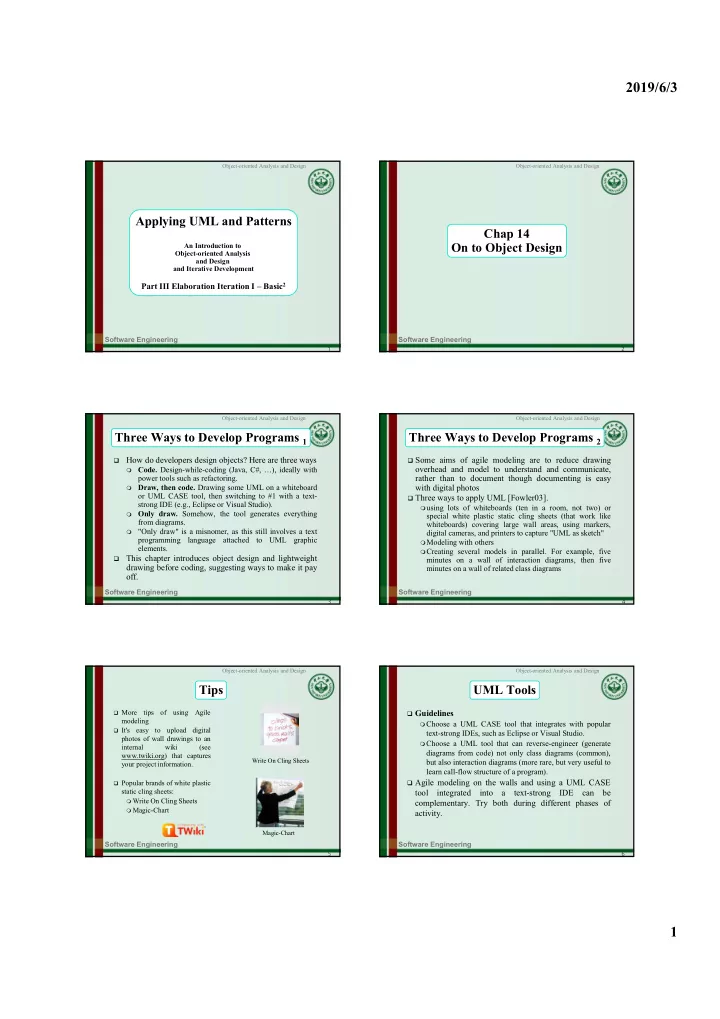

2019/6/3 Object-oriented Analysis and Design Object-oriented Analysis and Design Applying UML and Patterns Chap 14 On to Object Design An Introduction to Object-oriented Analysis and Design and Iterative Development Part III Elaboration Iteration I – Basic 2 Software Engineering Software Engineering 1 2 Object-oriented Analysis and Design Object-oriented Analysis and Design Three Ways to Develop Programs 1 Three Ways to Develop Programs 2 How do developers design objects? Here are three ways Some aims of agile modeling are to reduce drawing overhead and model to understand and communicate, Code. Design-while-coding (Java, C#, …), ideally with power tools such as refactoring. rather than to document though documenting is easy Draw, then code. Drawing some UML on a whiteboard with digital photos or UML CASE tool, then switching to #1 with a text- Three ways to apply UML [Fowler03]. strong IDE (e.g., Eclipse or Visual Studio). using lots of whiteboards (ten in a room, not two) or Only draw. Somehow, the tool generates everything special white plastic static cling sheets (that work like from diagrams. whiteboards) covering large wall areas, using markers, "Only draw" is a misnomer, as this still involves a text digital cameras, and printers to capture "UML as sketch" programming language attached to UML graphic Modeling with others elements. Creating several models in parallel. For example, five This chapter introduces object design and lightweight minutes on a wall of interaction diagrams, then five drawing before coding, suggesting ways to make it pay minutes on a wall of related class diagrams off. Software Engineering Software Engineering 3 4 Object-oriented Analysis and Design Object-oriented Analysis and Design Tips UML Tools More tips of using Agile Guidelines modeling Choose a UML CASE tool that integrates with popular It's easy to upload digital text-strong IDEs, such as Eclipse or Visual Studio. photos of wall drawings to an Choose a UML tool that can reverse-engineer (generate internal wiki (see diagrams from code) not only class diagrams (common), www.twiki.org) that captures Write On Cling Sheets but also interaction diagrams (more rare, but very useful to your project information. learn call-flow structure of a program). Agile modeling on the walls and using a UML CASE Popular brands of white plastic static cling sheets: tool integrated into a text-strong IDE can be Write On Cling Sheets complementary. Try both during different phases of Magic-Chart activity. Magic-Chart Software Engineering Software Engineering 5 6 1
2019/6/3 ★ Object-oriented Analysis and Design ★ Object-oriented Analysis and Design How Much Time Spent Drawing Designing Objects UML Before Coding For a three-week timeboxed iteration, There are two kinds of object models: dynamic and static. spend a few hours or at most one day (with partners) near the start of the iteration "at the walls" (or with a UML Spend a short period of time on interaction diagrams CASE tool) (dynamics), then switch to a wall of related class Then stop - and if sketching - perhaps take digital photos, diagrams (statics). print the pictures, and transition to coding for the remainder of the iteration Using the UML drawings for inspiration as a starting point, but recognizing that the final design in code will diverge and improve . Shorter drawing/sketching sessions may occur throughout the iteration. Software Engineering Software Engineering 7 8 Object-oriented Analysis and Design ★ Object-oriented Analysis and Design Dynamic Object Modeling Static Object Modeling Most of the challenging, interesting, useful design work After first covering dynamic modeling with interaction happens while drawing the UML dynamic-view diagrams, we then do the static object modeling interaction diagrams If the developers are applying the agile modeling Spend significant time doing interaction diagrams practice of Create several models in parallel , they will (sequence or communication diagrams), not just class be drawing both interaction and class diagrams diagrams. concurrently. Ignoring this guideline is a very common worst-practice with UML. Software Engineering Software Engineering 9 10 Object-oriented Analysis and Design Object-oriented Analysis and Design ★ ★★★ Object Design Skill Fundamental object design The importance of object design skill is over UML notation skill The object design skills are what matter, not knowing What's important is knowing how to think and design in objects, how to draw UML. Fundamental object design requires and apply object design best-practice patterns , which is much knowledge of: more valuable skill than knowing UML notation principles of responsibility assignment Drawing UML is a reflection of making decisions about the design patterns design While drawing a UML object diagram, we need to answer key questions: What are the responsibilities of the object? Who does it collaborate with? What design patterns should be applied? Far more important than knowing the difference between UML 1.4 and 2.0 notation! Therefore, the emphasis of the following chapters is on these principles and patterns in object design. Software Engineering Software Engineering 11 12 2
2019/6/3 Object-oriented Analysis and Design Object-oriented Analysis and Design × × Class Responsibility Card CRC Examples A CRC modeling session involves a group sitting around a table, discussing and writing on the cards as they play "what if" scenarios with the objects, considering what they must do and what other objects they must collaborate with. Each card represents one class More detailed: http://c2.com/doc/crc/draw.html Software Engineering Software Engineering 13 14 3
Recommend
More recommend